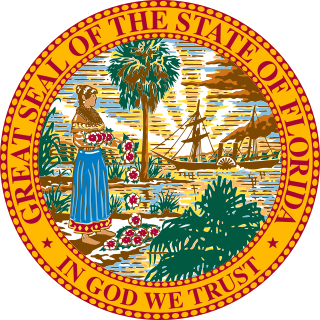Related Research Articles
The following outline is provided as an overview of and introduction to law:
In the United States, state law refers to the law of each separate U.S. state.

The government of Florida is established and operated according to the Constitution of Florida and is composed of three branches of government: the executive branch consisting of the governor of Florida and the other elected and appointed constitutional officers; the legislative branch, the Florida Legislature, consisting of the Senate and House; and the judicial branch consisting of the Supreme Court of Florida and lower courts. The state also allows direct participation of the electorate by initiative, referendum, and ratification.
The Ohio Revised Code (ORC) contains all current statutes of the Ohio General Assembly of a permanent and general nature, consolidated into provisions, titles, chapters and sections. However, the only official publication of the enactments of the General Assembly is the Laws of Ohio; the Ohio Revised Code is only a reference.

The California Codes are 29 legal codes enacted by the California State Legislature, which, alongside uncodified acts, form the general statutory law of California. The official codes are maintained by the California Office of Legislative Counsel for the legislature. The Legislative Counsel also publishes the official text of the Codes publicly at leginfo.legislature.ca.gov.

The law of California consists of several levels, including constitutional, statutory, and regulatory law, as well as case law. The California Codes form the general statutory law, and most state agency regulations are available in the California Code of Regulations.
The law of Colorado consists of several levels, including constitutional, statutory, regulatory, local, and case law. The Colorado Revised Statutes form the general statutory law.
The law of Virginia consists of several levels of legal rules, including constitutional, statutory, regulatory, case law, and local laws. The Code of Virginia contains the codified legislation that define the general statutory laws for the Commonwealth.

The law of New York consists of several levels, including constitutional, statutory, regulatory and case law, and also includes local laws, ordinances, and regulations. The Consolidated Laws form the general statutory law.
The law of Texas is derived from the Constitution of Texas and consists of several levels, including constitutional, statutory, regulatory law, as well as case law and local laws and regulations.
The law of Illinois, a state of the United States, consists of several levels, including constitutional, statutory, and regulatory law, as well as case law and local law. Illinois state law is promulgated under the Illinois State Constitution. The Illinois Compiled Statutes (ILCS) form the general statutory law. The case law of the Illinois Supreme Court and state appellate courts is currently published online under a public domain reporting system. Interpretations of law and conflicts among the various levels of law are referred to the Illinois courts in suits for application of common law. The states administrative law is published in codified form in the Illinois Administrative Code. Local ordinances are published by the respective local authorities, which are granted that authority under state law.
The law of Pennsylvania consists of several levels, including constitutional, statutory, regulatory and case law. The Pennsylvania Consolidated Statutes form the general statutory law.
The law of Ohio consists of several levels, including constitutional, statutory, and regulatory, local and common law. The Ohio Revised Code forms the general statutory law.
The law of the U.S. state of Georgia consists of several levels, including constitutional, statutory, and regulatory law, as well as case law and local law. The Official Code of Georgia Annotated forms the general statutory law.

The law of Michigan consists of several levels, including constitutional, statutory, regulatory and case law. The Michigan Compiled Laws form the general statutory law.
The law of North Carolina consists of several levels, including constitutional, statutory, regulatory, case law, and local law.
The law of New Jersey consists of several levels, including constitutional, statutory, regulatory, case law, and local law.
The law of Massachusetts consists of several levels, including constitutional, statutory, regulatory, case law, and local ordinances. The General Laws of Massachusetts form the general statutory law.

The law of Minnesota refers to the legal framework that governs the U.S. state of Minnesota. It is a combination of the federal legal system, applicable throughout the United States, and state-specific laws and regulations. Minnesota has its own constitution, first ratified in 1857, which provides the fundamental structure and guidance for the state's legal processes.
The law of Washington consists of several levels, including constitutional, statutory, regulatory and case law, as well as local ordinances. The Revised Code of Washington forms the general statutory law.
References
- 1 2 "Statutes & Constitution: Online Sunshine". Florida Legislature . Retrieved 26 September 2013.
- ↑ "Florida Administrative Code - Florida Administrative Law - Guides @ UF at University of Florida". University of Florida Libraries. Archived from the original on 27 September 2013. Retrieved 26 September 2013.
- ↑ "Florida Administrative Register - Florida Administrative Law - Guides @ UF at University of Florida". University of Florida Libraries. Archived from the original on 27 September 2013. Retrieved 26 September 2013.
- ↑ "Agency Adjudication - Florida Administrative Law - Guides @ UF at University of Florida". University of Florida Libraries. Archived from the original on 27 September 2013. Retrieved 26 September 2013.
- 1 2 "Florida Caselaw - Florida Caselaw - Guides @ UF at University of Florida". University of Florida Libraries. Archived from the original on 27 September 2013. Retrieved 26 September 2013.
- ↑ Sherwood, Frank (2008). County Governments In Florida. iUniverse. pp. 128–129, 154–162. ISBN 978-0-595-48160-6.
- ↑ "Legal Encyclopedias - Legal Research Guides - Guides @ UF at University of Florida". University of Florida Libraries. Retrieved 26 September 2013.
- ↑ Reed, Matt (24 May 2009). "Watchdog column:Suit sets limits on liability of country". Melbourne, Florida: Florida Today. pp. 1B.
- ↑ Pan-Am Tobacco v. Department of Corrections, 471 So.2d 4 (Fla. 1984).